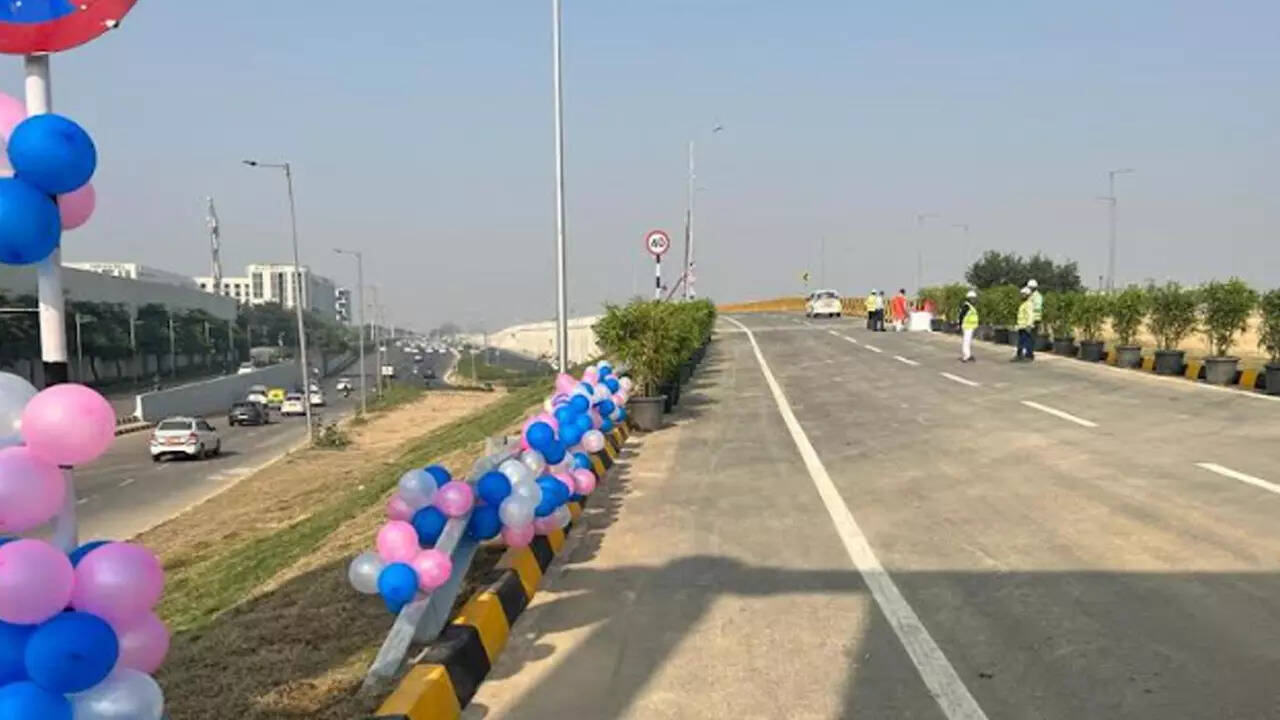[ad_1]
NEW DELHI: The Delhi airport got two new approach flyovers — Aerocity flyover and Parallel Access Road flyover — on Wednesday which are expected to provide relief to flyers from the city’s perpetual traffic congestion. But those required to transit between T1 on one side and T2 and T3 on the other will benefit more when either IGIA gets an air train or the almost five-year-old proposal for a Y-shaped mini flyover on the crossing that links city side to T1 becomes a reality.
The Aerocity flyover, a four-lane one-way flyover constructed at Aerocity metro station junction, will reduce travel time from T1 to T3 of Delhi airport by making a signal free movement. The flyover commences from in front of Andaz Hotel, Aerocity (West side) and ends at Central spine road, terminating short of the Eastern Cross Taxiway.
The Parallel Access Road (PAR) flyover is part of a dedicated corridor of two lanes on both carriageways for cargo terminal (To and Fro) of the airport, with a flyway close to NH-8. The corridor commences close to Hanuman temple and ends near Andaz Hotel, whereby segregating the heavy vehicular movement from passenger vehicles and further helping decongest the airport approach road.
“With a total length of the Aerocity flyover and PAR flyover being 800 meters and 600 metres, respectively, the flyovers will help create a signal free movement between the three terminals of the Delhi airport and further restrict the movement of heavy vehicles on the airport approach road whereby ensuring a seamless transit passage towards and from Delhi airport,” Delhi International Airport Ltd (DIAL) said in a statement.
GMR Group deputy group MD I Prabhakara Rao said, “Passenger experience is paramount for the GMR Group. Keeping this in view, two new flyovers have been constructed to help ease the transit to and from Delhi airport and provide seamless passage for the passengers.”
In 2019, months before Covid outbreak, DIAL had proposed to make the traffic crossing from where passengers coming from the city side turn left towards T3 or go straight to T1, signal free, with a Y-shaped mini flyover. This was to have a two-way access between roads leading to T3 and Dwarka. The third leaf was to be one-way and taken by people driving from T1 and going towards T3. This would have made the crossing signal free. This plan has, however, remained only on paper.
The Aerocity flyover, a four-lane one-way flyover constructed at Aerocity metro station junction, will reduce travel time from T1 to T3 of Delhi airport by making a signal free movement. The flyover commences from in front of Andaz Hotel, Aerocity (West side) and ends at Central spine road, terminating short of the Eastern Cross Taxiway.
The Parallel Access Road (PAR) flyover is part of a dedicated corridor of two lanes on both carriageways for cargo terminal (To and Fro) of the airport, with a flyway close to NH-8. The corridor commences close to Hanuman temple and ends near Andaz Hotel, whereby segregating the heavy vehicular movement from passenger vehicles and further helping decongest the airport approach road.
“With a total length of the Aerocity flyover and PAR flyover being 800 meters and 600 metres, respectively, the flyovers will help create a signal free movement between the three terminals of the Delhi airport and further restrict the movement of heavy vehicles on the airport approach road whereby ensuring a seamless transit passage towards and from Delhi airport,” Delhi International Airport Ltd (DIAL) said in a statement.
GMR Group deputy group MD I Prabhakara Rao said, “Passenger experience is paramount for the GMR Group. Keeping this in view, two new flyovers have been constructed to help ease the transit to and from Delhi airport and provide seamless passage for the passengers.”
In 2019, months before Covid outbreak, DIAL had proposed to make the traffic crossing from where passengers coming from the city side turn left towards T3 or go straight to T1, signal free, with a Y-shaped mini flyover. This was to have a two-way access between roads leading to T3 and Dwarka. The third leaf was to be one-way and taken by people driving from T1 and going towards T3. This would have made the crossing signal free. This plan has, however, remained only on paper.
[ad_2]
Source link





